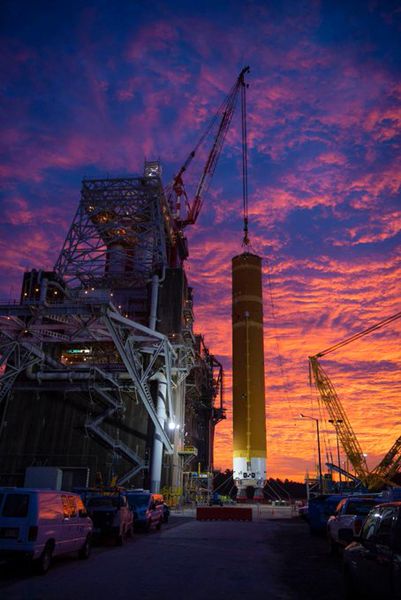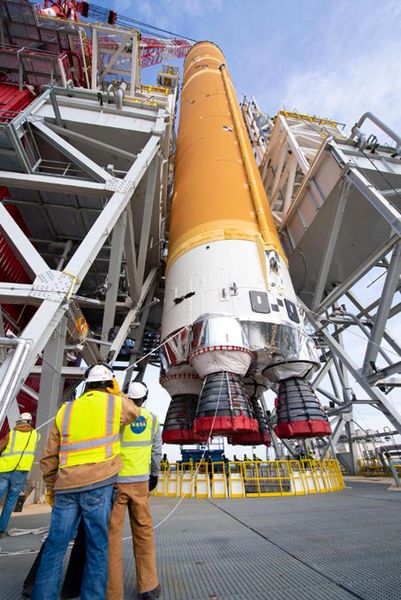
NASA / SSC
NASA Artemis Program and Stennis Space Center Set the Stage for Testing in 2020 (News Release)
All eyes are on south Mississippi with this month’s delivery and installation of NASA’s Space Launch System (SLS) rocket’s first core stage to Stennis Space Center for a milestone Green Run test series prior to its Artemis I flight.
The Green Run testing will be the first top-to-bottom integrated testing of the stage’s systems prior to its maiden flight. The testing will be conducted on the B-2 Test Stand at Stennis, located near Bay St. Louis, Mississippi, and the nation’s largest rocket propulsion test site. Green Run testing will take place over several months and culminates with an eight-minute, full-duration hot fire of the stage’s four RS-25 engines to generate 2 million pounds of thrust, as during an actual launch.
“This critical test series will demonstrate the rocket’s core stage propulsion system is ready for launch on missions to deep space,” Stennis Director Rick Gilbrech said. “The countdown to this nation’s next great era of space exploration is moving ahead.”
NASA is building SLS as the world’s most-powerful rocket to return humans to deep space, to such destinations as the Moon and Mars. Through the Artemis program, NASA will send the first woman and next man to the Moon by 2024. Artemis I will be a test flight without crew of the rocket and its Orion spacecraft. Artemis II will carry astronauts into lunar orbit. Artemis III will send astronauts to the surface of the Moon.
The SLS core stage, the largest rocket stage ever built by NASA, stands 212 feet tall and measures 27.6 feet in diameter. It is equipped with state-of-the-art avionics, miles of cables, propulsion systems and propellant tanks that hold a total of 733,000 gallons of liquid oxygen and liquid hydrogen to fuel the four RS-25 engines during launch. The core stage was designed by NASA and Boeing in Huntsville, Alabama, then manufactured at NASA’s Michoud Assembly Facility in New Orleans by lead contractor Boeing, with input and contributions from more than 1,100 large and small businesses in 44 states.
“Delivering the Space Launch System rocket core stage to Stennis for testing is an epic historical milestone,” said Julie Bassler, the SLS stages manager. “My team looks forward to bringing this flight hardware to life and conducting this vital test that will demonstrate the ability to provide 2 million pounds of thrust to send the Artemis I mission to space.”
The stage was transported from Michoud to Stennis aboard the specially outfitted Pegasus barge. It arrived at the B-2 dock on Jan. 12 and was rolled out onto the test stand tarmac that night. Crews then began installing ground equipment needed for lifting the stage into a vertical position and onto the stand.
The lift was performed Jan. 21-22, which provided optimal weather and wind conditions. Crews now will fully secure the stage in place and to stand systems for testing.
NASA completed extensive modifications to prepare the B-2 stand for the test series. The stand has a notable history, having been used to test Saturn V stages that helped launch astronauts to the Moon as part of the Apollo Program and the three-engine propulsion system of the space shuttle prior to its first flight.
Preparing the stand for SLS core stage testing required upgrades of every major system on the stand, as well as the high pressure system that provides hundreds of thousands of gallons of water needed during a test. It also involved adding 1 million pounds of fabricated steel to the Main Propulsion Test Article framework that will hold the mounted core stage and extending the large derrick crane atop the stand that will be used to lift the SLS stage into place.
Once installed on the stand, operators will begin testing each of the stage’s sophisticated systems. Among other things, they will power up avionics; conduct main propulsion system and engine leak checks; and check out the hydraulics system and the thrust vector control unit that allows for rotating the engines to direct thrust and “steer” the rocket’s trajectory.
They also will conduct a simulated countdown, as well as a “wet dress rehearsal,” in which propellants are loaded and flow throughout the stage system. The rehearsal exercise will end just prior to engine ignition, with the full four-engine hot fire to come in subsequent days.
After the hot fire test, crews plan to perform refurbishment work on the stage and inspect and configure it for shipment to Kennedy Space Center. The stage will be removed from the stand, lowered to its horizontal position on the tarmac and reloaded into Pegasus for the trip to Florida.
At Kennedy, the stage will be joined with other SLS elements and prepared for launch. The next time its four RS-25 engines fire, Artemis I will be taking flight.
Source: NASA.Gov
****

NASA / SSC

No comments:
Post a Comment